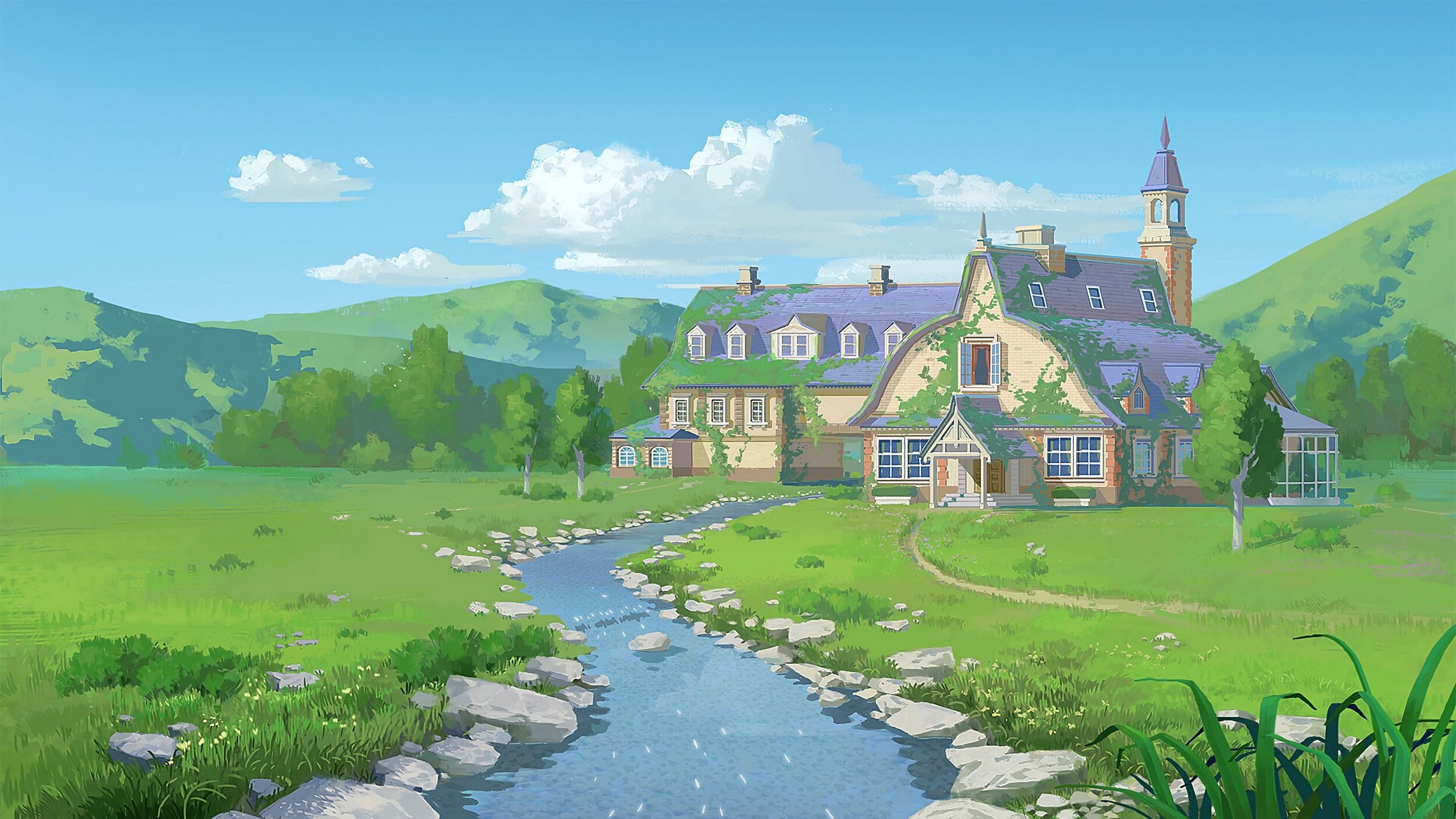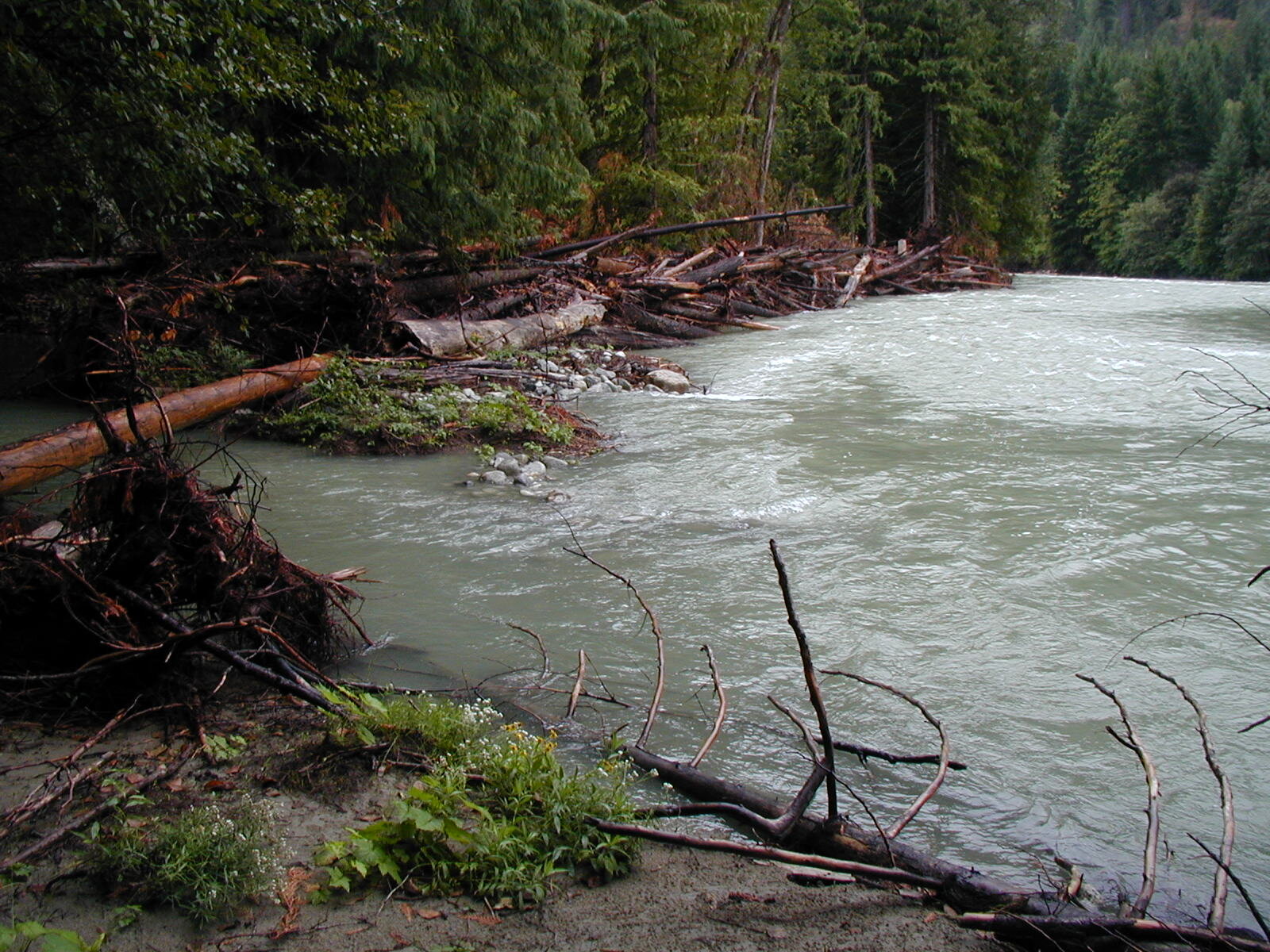Logjams and Large Wood in Rivers
“Stehekin River Logjam” by Paul Bakke
Often it seems that the ordinary days of my career as a river scientist run together. But the frustrating days stand out, each in their own particular way. The day that I was told that a previously agreeable landowner had rejected a proposal to build an engineered logjam on his portion of the river because he didn’t want to look at it from his kitchen window was one such time. We thought we had done such a thorough job making the case that logjams would convert the canal-like river channel into spectacular salmon habitat, in a way that would be self-sustaining. And moreover, that the river had been full of logs and logjams for thousands of years before the predecessors of this landowner had pulled them out and straightened the river, causing it to need recurrent dredging, creating unstable banks that needed to be armored with boulders, and decimating the salmon population. We lost the argument because, well, logjams are ugly. If something is perceived as ugly, science doesn’t matter.
Perception of beauty in Euro-American culture contrasts dramatically with what is found in nature.
Nature isn’t always pretty, at least not in the sense that the dominant thinking in our Euro-American culture defines “pretty.” Many hotel rooms and lobbies are graced by fanciful artwork showing neat rustic cottages set alongside of beautiful meadow-lined streams, with clear water tumbling over clean pebbles and not a sign of unkempt vegetation or erosion or debris. There is something in the psyche of this culture, of many cultures throughout the modern world, which expects and strives towards this sort of imagined tidiness.
But rivers, real ones, that is, are not tidy. Trees fall into the river. Riverbanks erode. Branches and trees wash downstream into chaotic -looking logjams. Shrubs and gangly young trees grow dense along riverbanks, hiding the river from view and impeding progress of fishermen walking along the bank.
In every part of the world where rivers run through forests, those rivers originally were full of wood, ranging in size from twigs and branches to large old-growth trees. So, through most of the history of the planet, including most of human history, when the people who lived along rivers were less inclined to be dissatisfied with the way rivers looked, untidy nature ruled supreme. Single logs and logjams were the norm. The moving water interacted with these logs, moving them, piling them, and changing course in response to them. In doing this, a complex and dynamically changing river environment was created. Wildlife, and most of all fish, thrived in this messy environment. The Pacific Northwest salmon, for example, evolved to succeed in a world filled with large wood.
The Role of Large Wood
The list of ways that large wood affects the form and behavior of rivers Is long, so to keep this chapter manageable, let’s focus on two of the most important ones: building an alluvial streambed, and governing channel migration. Both of these things are ecological benefits, from the point of view of creating and maintaining fish habitat. In recognition of the beneficial function of large wood, river scientists have largely stopped using the older, derogatory term “large woody debris.” Debris is something to be cleaned up and thrown away. The way we use language always matters.
In rivers that are about one half to one times as wide the larger trees growing along their banks are tall, trees that fall in the river can create channel-spanning blockages. Water is forced over the log, plunging to form a pool on the downstream side, and slowing and flattening flow on the upstream side. This causes the channel on the upstream side of the log to accumulate gravel and sand, creating a deep wedge of alluvial sediment.
Over decades and centuries, more trees fall in. The overall roughness or friction that the water must overcome as it flows down the valley, increases as the water must now flow around and over these logs. Increased friction from obstacles means less energy available to move sediment, so the streambed becomes thicker, and dominated by a range of sizes sizes of gravel and sand grains. A coarse, cobbly streambed may become looser, with cobbles dispersed among patches of finer gravels and sands.
In contrast to a river with no logs, this large-wood-rich river as a more diverse or complex habitat. Slack water areas with low velocity water alternate with swiftly-flowing riffles. Deep plunge pools alternate with shallow bars. The river’s edge becomes becomes a place better shielded from the main current, with pockets of deep, still water and back-eddies. The curtain of bubbles and turbulence of plunging water, and the crevices underneath pieces of large wood create hiding places and cover for fish to escape predators and watch for food. Plunging oxygenates the water, and the steps in the upstream to downstream profile of the streambed created by logs force some of that water down into the gravel streambed, were it becomes hyporheic flow. As hyporheic flow, it cools and cleanses itself, and nurtures insects and fish eggs in the streambed.
The river with no logs has nothing to hold its alluvial streambed place, if there even is one begin with. There is no skeleton to resist the downstream force of gravity, washing the gravel and sand away during high water. It is common for a river that has lost its logs due to people pulling them out, or lost its source of logs due to cutting down the trees along the river, to erode its streambed. The streambed can erode down to dense, interlocking cobbles. Often the streambed erodes down to bedrock. Bedrock streams can be picturesque, but they are not generally good habitat for fish. They lack the complexity of depth and velocity, and without a hyporheic zone, lack the ability to buffer hot summer temperatures. During high water they become bedrock chutes, quickly moving the water, and everything else, downstream, bypassing the floodplain, and are unable to hold anything but the smallest pockets of gravel within the channel.
In rivers that are wide enough to float and move whole trees, logjams will form, adding another whole dimension to river behavior. A logjam begins to form when a particularly large log, usually with roots attached, wedges into the streambed. Typically, this will happen at the shallow upstream end of a gravel bar. This log becomes what river scientists call a “key piece,” and other logs moving down stream get hung up on this anchor log. As the logjam grows, it can strain out and retain ever smaller pieces of large wood. The logjam deflects the flow of water both right and left as rushes downstream. Behind the logjam, gravel and sand deposit in the area protected from the flow. Eventually, this protected area will begin to grow trees. It becomes a forested island, separated from the rest of the floodplain by channels on either side. One of those channels usually is the main channel, receiving most of the water. The other channel becomes a side channel, which may have no flow or only a small fraction of the flow during low water. This type of logjam is called a bar apex jam.
The side channel becomes an important part of the river habitat. It is a place of lower velocity water during floods, where fish can go to escape being washed downstream. It can become a preferred spawning site for some species of fish, since the streambed in the side channel is be less prone to disturbance from the scouring force of water than the main channel. During lower water flow conditions, hyporheic water may be flowing just beneath the surface of an otherwise dry streambed, emerging at the downstream end of the side channel, and creating ideal habitat and spawning conditions for some species of fish. In the Pacific Northwest, the chum salmon is famous for preferring this habitat.
Bar apex jams can be remarkably stable, lasting for decades, long enough to grow mature forests on the island behind them. Eventually, a log may become wedged across the main channel at the bar apex jam, forcing the majority of the water into the side channel. When this happens, the side channel scours and widens, becoming the main channel and the main channel becomes a new side channel. This new side channel has a clean bed, devoid of the decades-long accumulation of branches, leaves, fine sediments and plants that have taken root in older side channels. It is through this process of switching from one channel to another, suddenly, during the storm, that side channels are created and renewed. Without this process of renewal, which is called channel avulsion, side channels will disappear, after the existing side channels eventually fill in.
The type of river channel created by this dynamic interaction of flowing water with logjams is called the “Island braided” or “anastomosing” channel. Anastomosing is a medical term referring to the way blood vessels diverge and come together in the human body. Over the centuries, as the river forms more and more of these splits and convergences across the floodplain, the valley-bottom habitat becomes extremely rich for both fish and terrestrial wildlife. The floodplain also stores large amounts of gravel and sand as this process of channel migration takes place, with sediment accumulating on growing islands, and in side channels. Future logjams create channel avulsions which cut into these old deposits of sediment, mobilizing it, and seeding the streambed downstream with fresh, loose gravel gravel.
Hoh River, Washington, from the air
The Island-braided channel type used to be very common in the Pacific Northwest, especially in rivers with ample sediment supply in their headwaters, and high rates of sediment movement. Downstream from big sources of sediment, such as volcanoes or glaciers, Island-braided channels created broad valleys with deep accumulations of gravel and sand, as well as large amounts of logs, many of them buried temporarily, to be encountered by future channel migration. These areas were among the richest salmon habitat.
I suppose it’s not hard to understand why rivers with logjams are at odds with Euro-American civilization. The role logjams play in avulsion and other forms of channel migration creates uncertainty, threatens the desire to keep the river in one place for now and always. Moreover, logjams impede transportation by water, and were perceived as being blockages to fish migrations as well. That, in spite of the obvious fact that fish were being caught above as well as below the logjams (It turns out that logjams have networks of internal passageways that actually expand when high water floats the logs). Finally, people thought that logjams were ugly, a feature of untamed, untidy nature, that just had to go.
We now know enough of the science of large and wood logjams to know better. Most of the current efforts to restore salmon habitat involve putting logs or logjams back in the river. And yet, we still fear and loathe them.
Sometimes I dream about traveling around, staying in hotels that have those fantasy paintings of a cottage built too close to a river that is too tidy, and replacing the painting with a framed photograph of a beautiful, fully-functioning logjam, in a place where salmon still thrive.
Would it make a difference?





